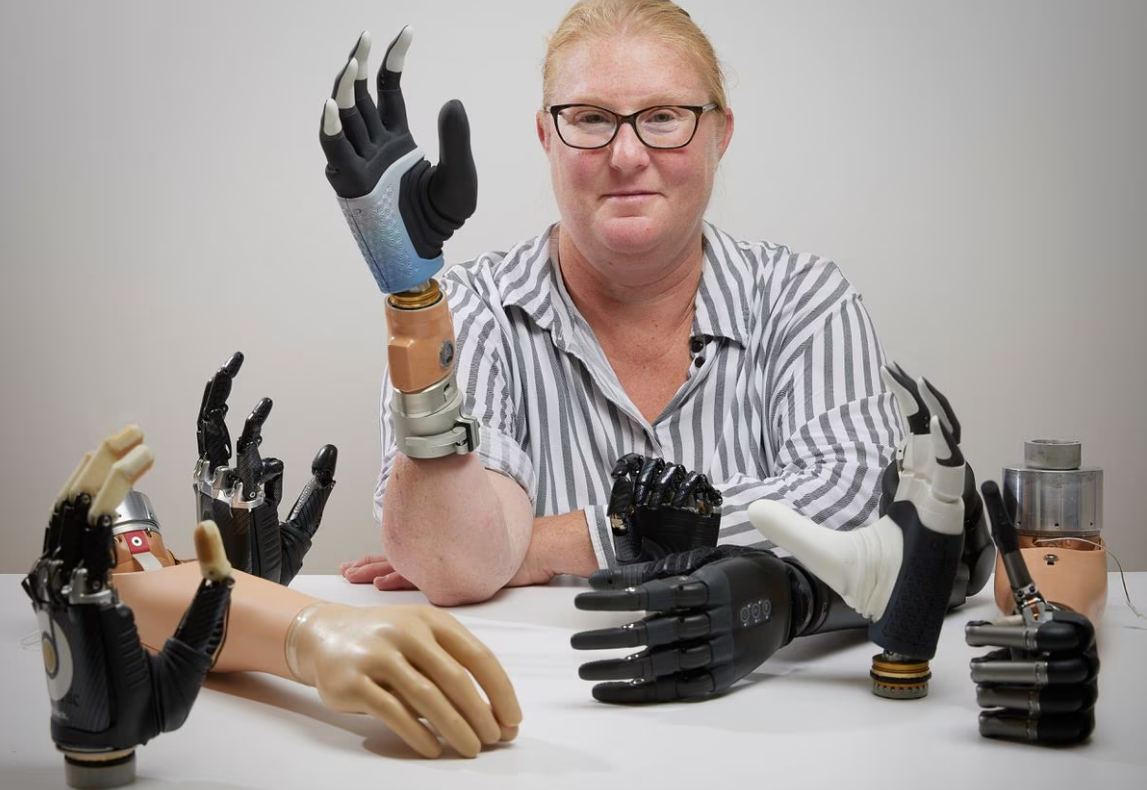(The Above Photo shows Karin, a Swedish woman, who has been living with a bionic hand for the past three years. Photo Courtesy of ORTIZ-CATALAN ET AL., SCI. ROB., 2023)
The two most significant challenges for individuals seeking artificial limb replacement are reliable control and mechanical attachment. Even sophisticated technologies are often rejected because of how painful or unreliable the prostheses become when trying to use them.
A group of surgeons and engineers came together to solve these concerns by developing a human-machine interface that permits a more comfortable interface. It involves a comfortable attachment to the patient’s skeleton using osseointegration with implanted electrodes to allow for electrical connections to the nerves and muscles. [1] In other words it gives the person with the implanted prosthesis the ability to control it using their own nervous and muscular system.
By combining osseointegration with reconstructive surgery, implanted electrodes, and AI, we can restore human function in an unprecedented way,” said Professor Rickard Brånemark, CEO of Integrum, the organization that led the patient surgery and has worked with osseointegration since it was first used in humans. [2]
"The biological integration of titanium implants into bone tissue creates opportunities to further advance amputee care.”
Meet Karin- Known Today as the Bionic Woman
Karin lost her right arm during a farming accident more than two decades ago. Since then, she has reported ongoing and excruciating phantom pain.
“It felt like I constantly had my hand in a meat grinder, creating a high level of stress,” she said, “I had to take high doses of various painkillers.”
More traditional prosthetic designs were unwieldy and cumbersome, essentially providing her with zero functional support. When the technology became available to let her wear something with higher integration with her residual limb, the pain relief was almost immediate. [3]
“For me, this research has meant a lot because it has given me a better life,” Karin said.
Professor Brånemark noted that Karin was the first person with below-elbow amputation to receive a highly integrated bionic hand for reliable and independent use. “The fact that she has been able to use her prosthesis comfortably and effectively in daily activities for years is a promising testament to the potential life-changing capabilities of this novel technology for individuals facing limb loss,” he said.
The Technology Allows for 80% of Daily Living Activities
According to Dr. Francesco Clemente, the Managing Director of Prensilia and developer of the robotic hand, the acceptance of the prosthesis is critical for it to be successfully used. The product is called “Mia Hand,” and it features unique motor and sensory components. [5]
Besides technical performance, Prensilia struggled to develop a hand that could be fully customizable aesthetically. Mia Hand was born to be shown and not hidden,” said Clemente. “We wanted the users to be proud of what they are, rather than ashamed of what was lost."
Dr. Paolo Sassu was responsible for the part of the surgery where sources of motor control information could be transitioned to the prosthesis through nerve and muscle rearrangement in the residual limb. “Depending on the clinical conditions, we can offer the best solution for our patients which sometimes is biological with a hand transplantation, and sometimes is bionic with neuromusculoskeletal prosthesis. We are continuously improving in both."
Dr. Sassu currently works with the Istituto Ortopedico Rizzoli in Italy and the Center for Bionics and Pain Research in Sweden.
Karin says the work allows her more control over the prosthesis, even with long-term daily wear. “Today, I need much less medication,” she said.
The possibilities seem endless, and the integration of AI could make mechanical prosthetics not just functional replacements but genuinely smart, intuitive extensions of the human body. These technologies are no longer just ideas found in science fiction. For Karin and others, they have become a daily reality.
Why Modern Prosthesis Technologies Are Making a Huge Difference
The future of mechanical prosthesis technology looks pretty exciting. There are multiple leaps in materials science, biomechanics, and even AI integration to consider.
For starters, we can look at the advancements in the materials used. Manufacturers are implementing carbon fiber and advanced polymers offering similar flexibility and strength to a person’s natural limbs.
Customization is now more available than ever before. 3D printing is making it easier to tailor prosthetics to individual needs. Patients could essentially have a limb that's as unique as they are.
Here are five other critical technological areas under development that researchers expect to have a dramatic impact on patient lives soon.
- More natural movements are becoming possible. Future prosthetics aim to mimic the natural gait and motion patterns of human limbs.
- Sensory Feedback. Researchers are working on providing tactile interactions with the surrounding environment, allowing patients to feel similar experiences as they did before.
- Smart Tech. Picture a prosthetic limb with built-in sensors that adapt to different terrains or activities. Going for a run? Your prosthetic could adjust in real-time for better performance.
- Thought Integration. More prosthetics incorporate brain-machine interfaces that let patients command the limb by thinking about what they want to accomplish.
- Simplified Manufacturing. As technology evolves, there's hope that costs will come down, making these advanced prosthetics more accessible to everyone.
Artificial intelligence adds a layer of adaptive learning to the equation. It helps the prosthetic learn a patient’s movements and habits, predicting what the individual does next to adjust itself accordingly. Failsafes to prevent falls or reduce damage during an injury event could work toward fewer long-term recovery needs. [4]
With AI, a prosthetic could talk to a patient’s smartphone, smartwatch, or even healthcare systems, providing a seamless flow of data and control. As prosthesis technology continues to experience remarkable advances, it will give life back to those who have lost something. It will inspire hope in those who have lost a limb that they can live what might feel like a normal life again.
References:
[1] https://www.science.org/doi/10.1126/scirobotics.adf7360
[2] https://medicalxpress.com/news/2023-10-bionic-merges-user-nervous-skeletal.html
[3] https://www.youtube.com/watch?v=tkDCCZB9kAI&t=2s
[4] https://www.wevolver.com/article/how-ai-is-helping-power-next-generation-prosthetic-limbs












